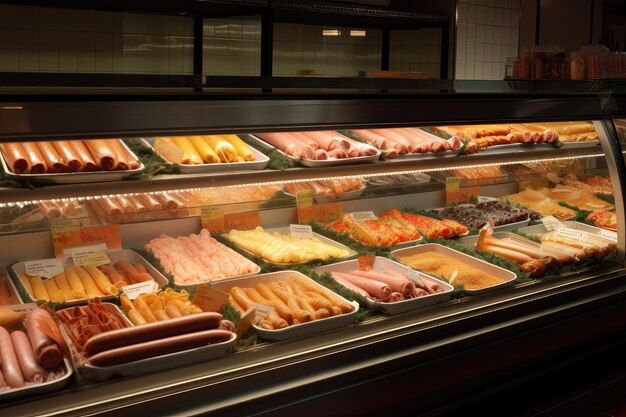How Long Can Cold Cuts Safely Stay in Your Refrigerator?
Are you a fan of cold cuts? Whether you prefer turkey, ham, or salami, these deli delights often find their way into sandwiches, snacks, and appetizers. But as convenient as they are, questions often arise about their shelf life. How long do cold cuts last in the refrigerator, and what are the best practices for storing them? Let's explore these questions and more to ensure your cold cuts not only taste great but also remain safe to eat.
🥪 The Basics: Understanding Cold Cut Shelf Life
When it comes to cold cuts, storage conditions and time play crucial roles in maintaining their quality and safety. Since cold cuts are perishable, they must be handled correctly to minimize the risk of foodborne illness.
Factors Influencing Shelf Life
Type of Cold Cut: Pre-packaged vs. Freshly Sliced
- Pre-packaged cold cuts often contain preservatives and are vacuum-sealed, making them last longer.
- Freshly sliced cold cuts from the deli are exposed to air more quickly, reducing their shelf life.
Storage Temperature
- Cold cuts should be stored in the refrigerator at or below 40°F (4°C) to slow bacterial growth.
Packaging and Contamination
- Properly wrapped or sealed packages prevent exposure to contaminants.
- Cross-contamination from other food can accelerate spoilage.
General Guidelines for Refrigerated Cold Cuts
- Pre-packaged cold cuts: Typically last about 2 weeks unopened; once opened, use them within 3 to 5 days.
- Freshly sliced deli meats: Best consumed within 3 to 5 days of purchase.
🗓️ Extending Freshness: Tips for Storing Cold Cuts
Maximizing the freshness of your cold cuts relies on proper storage tactics. Here are some strategies:
Optimal Storage Techniques
Keep it Sealed: Invest in airtight containers or high-quality resealable bags. This minimizes exposure to air and bacteria.
Use the Deli Drawer: Utilize the designated meat drawer in your refrigerator, designed to maintain an ideal environment for meats.
Label and Date: Regularly label your cold cuts with the purchase date to track their freshness.
Observing Safe Practices
- Cleanliness is Key: Ensure your hands and surfaces are clean when handling cold cuts to prevent contamination.
- Separate from Raw Foods: Store cold cuts away from raw meats or seafood to avoid cross-contamination.
Quick Reference Table: Cold Cut Storage
| Type of Cold Cut | Unopened Shelf Life | Opened Shelf Life |
|---|---|---|
| Pre-packaged | Up to 2 weeks | 3-5 days |
| Freshly sliced | N/A | 3-5 days |
🛑 Recognizing Signs of Spoilage
Being able to identify when cold cuts have gone bad is essential for food safety. Here are some common indicators:
Spoilage Signals to Watch For
- Discoloration: Look for any unusual colors like gray or greenish hues.
- Slimy Texture: A slippery or sticky touch is a clear sign of spoilage.
- Off Odor: Any sour or unusual smell suggests the meat is past its prime.
- Taste Test: If it tastes off, it's best to discard it.
💡 Practical Tips and Mindful Eating
Engaging with mindful practices, from purchasing to consuming cold cuts, can ensure you enjoy your food while minimizing waste.
Savvy Consumer Tips
- Portion Planning: Buy just enough for your needs; frequent small purchases can keep your stock fresh.
- Diversify Usage: Incorporate cold cuts into various recipes to rotate inventory quickly.
- Use in sandwiches, salads, or as pizza toppings.
Eco-Friendly Approach
- Compost: If some cuts go bad, consider composting to minimize waste impact.
🤔 Frequently Asked Questions
What Should I Do with Expired Cold Cuts?
If your cold cuts have expired, it's safer to dispose of them rather than risk illness. Always prioritize safety over penny pinching.
Can I Freeze Cold Cuts to Extend Their Life?
Yes, freezing can extend their life. Wrap individual portions tightly in plastic and place in a freezer-safe bag. Use within 1-2 months for optimal quality.
Are All Cold Cuts Equally Perishable?
Different meats have varying shelf lives. For instance, cured meats like salami might last longer due to reduced moisture content and curing processes, while lean meats like turkey or chicken tend to spoil quicker.
🍽️ Conclusion: The Bottom Line on Cold Cuts
Storing cold cuts isn't just about convenience; it's a matter of safety. Understanding the nuances of shelf life, best storage practices, and spoilage signs equips you with the knowledge to enjoy these tasty treats safely. By keeping your refrigerator settings optimal and maintaining hygiene, your cold cuts can remain a fresh and delicious part of your meals. Remember, a little planning goes a long way—a strategy that ensures you're savoring every bite.
